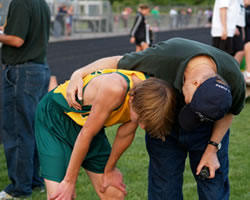The purpose of the following information is to provide people who care for kids with diabetes (such as teachers, childcare workers, coaches etc.), with basic information about diabetes.
This information will help you feel more comfortable and the child/adolescent will be safe. It is not meant to replace contact between the parent and you. Communications between you, the child and the parents is recommended on a regular basis.
The Balancing Act
The treatment of diabetes can be viewed as a balancing act. Food on the one side, increases the amount of glucose in the blood. Exercise and insulin on the other, lower the blood glucose level by allowing the glucose to be used for energy.
Blood glucose testing done by the kids with diabetes or the parents is a means of monitoring the blood glucose balance. When the blood glucose is in proper balance, the child/adolescent will feel well.
In terms of academic performance, physical activity and attendance at school, the teacher's expectations of students should be the same as if he or she did not have diabetes.
Food
Maintaining the proper balance of food and insulin is essential to achieving good blood glucose control. When the doctor and parents decide on an insulin dose for the child they are assuming that the food intake will be kept relatively constant.
You do not need to know the details of the meal plan to help kids with diabetes. You must simply understand that the diet for the child is based on the following principles: eating the same amount of food (carbohydrate content) each day; and eating meals and snacks at the same time each day.
These principles must be remembered, not only during the regular day, but also when on field trips and during detentions and other activities. It is usually possible to coordinate meal and snack times with typical daily schedules. For example, the child's snack can often be taken at recess or during the class snack time. Occasionally it will be necessary for the student to eat a snack during class and he or she should not be criticized or singled out for doing so. The use of "low noise" food such as cheese or dried fruit will minimize the disruption to the classroom.
Young children with diabetes may require extra supervision in the lunchroom to ensure that they eat most of what has been provided for them. Overeating or eating sweets, will not give rise to immediate problems, but is cause for concern if continued. You should simply advise the parent of such behaviour.
Missing a meal or snack or eating inadequately, however, is a much more serious problem and can easily give rise to a medical emergency, which requires immediate treatment. This situation, which is the result of very low blood glucose is called hypoglycemia. The appropriate action is immediate treatment with a readily absorbable form of sugar such as juice or regular pop. For more information please refer the section entitled "Hypoglycemia (Low Blood Glucose) - An Emergency!".
With a bit of planning, children with diabetes are able to eat many of the foods that all children love. If parents are notified ahead of time of parties, "hot dog days", or other special events involving food, the kids with diabetes should be able to enjoy them as much as everybody else.
Hypoglycemia (Low Blood Glucose) - An Emergency!
Causes
| Symptoms A person who is experiencing hypoglycemia will exhibit some of the following signs:
In addition the child may complain of:
| Treatment It is imperative at the first sign of hypoglycemia you give sugar immediately. If the parents have not provided you with more specific instructions which can be readily complied with, give:
|
It may take some coaxing to get the child to eat or drink but you must insist.
If there is no noticeable improvement in about 10 to 15 minutes repeat the treatment. When the child's condition improves he or she should be given solid food. This will usually be in the form of the child's next regular meal or snack.
Until the child is fully recovered he or she should not be left unsupervised. Once the recovery is complete the child can resume regular classwork. If, however, it is decided that the child should be sent home, it is imperative that he or she be accompanied by a responsible person.
Parents should be notified of all incidents of hypoglycemia. Repeated low blood glucose levels are undesirable and unnecessary and should be drawn to the parent's attention so that they can discuss the problem with their doctor.
If unsure whether the child is hypoglycemic, always give sugar! A temporary excess of sugar will not harm the child but hypoglycemia is potentially serious. [NOTE: Do not give food or drink if the child is unconscious. Roll the child on his/her side and seek medical assistance immediately.]
High Blood Glucose
Children with diabetes sometimes experience high blood glucose. The earliest and most obvious symptoms of high blood glucose are increased thirst and urination. If noticed, these should be communicated to the parents to assist them in the long-term treatment. They are not emergencies which require immediate treatment.
Causes
High blood glucose often develops as a result of one or more of the following:
- too much food;
